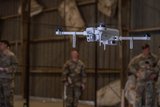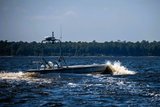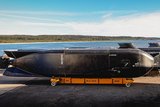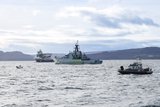South Korea to buy MK 54 torpedoes for helicopter use
A MK 54 lightweight torpedo is here seen upon launch. The ROKN is buying 31 such weapons. (USN)
On 15 July, the US State Department announced that approval had been granted to sell MK 54 lightweight torpedoes to South Korea under an FMS deal.
The prospective deal is worth $130 million, and it covers 31 torpedoes.
The Defense Security Cooperation Agency revealed that the deal also includes a recoverable exercise torpedo; a storage and issue facility; air launch accessories for rotary-winged aircraft; spare parts; torpedo containers; and support equipment and services.
The Republic of Korea Navy (ROKN) will use these MK 54 torpedoes from the MH-60R helicopters that it is awaiting from Sikorsky in the US.
The US DoD announced on 12 April 2021 that Seoul had ordered a dozen MH-60Rs for $447.23 million.
The ROKN already uses the K745 Blue Shark lightweight torpedo produced by LIG Nex1. In use since 2004, including from helicopters, it seems that South Korea is unwilling or not allowed to integrate the Blue Shark onto the Romeo platform, and hence this decision to buy MK 54s from the US.
The ROKN also uses MK 54 torpedoes in conjunction with P-8A Poseidon maritime patrol aircraft, with a $72 million sale for 31 torpedoes approved by the DSCA in August 2019.
Related Equipment in Defence Insight
More from Naval Warfare
-
![US Coast Guard pursues solutions to increase maritime domain dominance]()
US Coast Guard pursues solutions to increase maritime domain dominance
The USCG is seeking technologies, services and applications to better connect its assets and speed up the decision-making process.
-
![Canadian Coast Guard’s OOSV delivery is “major milestone” in fleet modernisation]()
Canadian Coast Guard’s OOSV delivery is “major milestone” in fleet modernisation
The Polar Class 6 platform is the largest CCG science-dedicated vessel and will operate on the country’s east coast.
-
![How the Anduril-HHI autonomous ship plan fits in with the US Navy’s MASC programme]()
How the Anduril-HHI autonomous ship plan fits in with the US Navy’s MASC programme
The new modular vessel is expected to be developed for both commercial and defence use, with a heavy focus on production speed and mission flexibility.
-
![Indo Pacific 2025: Autonomous systems reigned but can the Australian Defence Force afford it?]()
Indo Pacific 2025: Autonomous systems reigned but can the Australian Defence Force afford it?
Multiple autonomous systems and technologies were on display at this year’s Indo Pacific, but questions remain over how the Australian Department of Defence will balance the books.
-
![How the UK Royal Navy is powering up its hybrid fleet to combat new threats]()
How the UK Royal Navy is powering up its hybrid fleet to combat new threats
Since it announced its move towards a new “hybrid navy” earlier this year, the force has announced a number of new uncrewed technologies in the works.
-
![US and UK to begin Trident II D5 Increment 8 in October 2026]()
US and UK to begin Trident II D5 Increment 8 in October 2026
Trident II D5 Increment 8 will involve improvements to the shipboard navigation subsystem for the US Ohio and Columbia and the UK Dreadnought and Vanguard submarine classes.
























